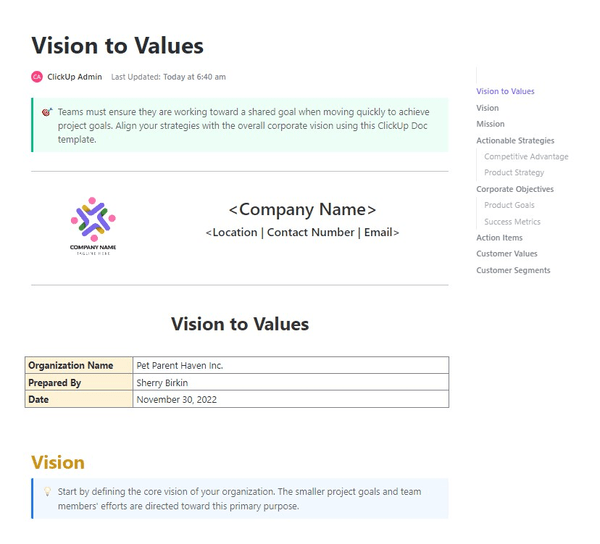هل تعني القيادة والإدارة نفس الشيء بالنسبة لك؟ لا تقلق، فأنت لست الوحيد! ومع ذلك، فإن هذا بالتأكيد ليس حالة أخرى من حالات القيادة والإدارة لأن المصطلحين ليسا مترادفين على الإطلاق.
في حين أن كلا المفهومين يركزان على تمكين الموظفين وتحقيق الأهداف التنظيمية، إلا أن الفرق الرئيسي بين القيادة والإدارة يكمن في وظائف كل منهما. على سبيل المثال، تتعلق مهارات القيادة بالتأثير على الآخرين، بينما تتضمن مهارات الإدارة تنفيذ العمليات بالتنسيق والتحكم.
في هذه المقالة، سوف نناقش في هذه المقالة القيادة مقابل الإدارة ونلقي الضوء على الاختلافات الأساسية بينهما على المستوى التنظيمي. كما سنستكشف أيضًا:
- مفاهيم القيادة والإدارة المتداخلة
- الاستراتيجيات والأدوات اللازمة لتسهيل تطوير الإدارة والقيادة
فهم مهارات القيادة
هل سبق لك أن شعرت بالتحفيز من خلال كلمات أو أفعال شخص آخر؟ على سبيل المثال، عن طريق اللياقة البدنية و المؤثر على الإنتاجية التي تهتم بتناول الطعام الصحي وإعداد الوجبات المنزلية والذهاب إلى صالة الألعاب الرياضية ثلاث مرات في الأسبوع! 🏋️
يلهمك القادة بطريقة مماثلة، فأفعالهم وسلوكهم يمنح مجموعة من الأشخاص دفعة تحفيزية إضافية للاستمرار وتحقيق الأهداف الجماعية. ويربط الكثيرون القيادة بالمناصب العليا في الشركة، مثل الرئيس التنفيذي أو الخبير الاستراتيجي، ولكن المفهوم يتعلق أكثر بامتلاك التأثير الاجتماعي وعقلية النمو لتشجيع الناس على اتخاذ الإجراءات (وليس إجبارهم على ذلك).
يميل القادة إلى التركيز على الصورة الكبيرة والاستفادة من جوانب التواصل وبناء الفريق للمضي قدمًا. فهم يضعون مهمة الشركة نصب أعينهم ويدعون كل عضو في الفريق للمساهمة في تحقيق رؤيتهم الاستراتيجية.
يتمحور أي دور قيادي رفيع المستوى حول إلهام ولاء الفريق ومعنوياته، وهو ما قد يبدو غامضًا. ومع ذلك، فإن القائد الجيد يتحلى بالمهارات الأربع الملموسة التالية التي تساعده على توجيه الفرق:
1. الرؤية لتوجيه الناس نحو نجاح الأعمال
يقدم القادة الفعالون رؤية لفريقهم، والتي يمكن ترجمتها إلى خطط قابلة للتنفيذ تحدد سير العمل اليومي للموظفين. يمكن أن تكون الرؤية نتيجة مرغوبة طويلة الأجل، مثل إنشاء أداة برمجية مبتكرة، أو تجديد ثقافة الشركة، أو توسيع نطاق العمليات على مستوى العالم.
نصيحة: يحتاج القادة الذين لديهم رؤية واضحة إلى التفكير في المستقبل وتحديد استراتيجيات قابلة للتنفيذ بشأن الأزرار التي يجب الضغط عليها للوصول إلى خط النهاية. وتتمثل إحدى طرق القيام بذلك في استخدام نموذج ClickUp من الرؤية إلى القيم . يقدم الدعم خطوة بخطوة للقادة أثناء تحويل بيانات الرؤية والرسالة إلى أهداف وغايات قابلة للقياس لتوجيه فريق التخطيط.
قم بمواءمة قيمك مع رؤيتك من خلال نموذج تحويل القيم إلى رؤية
2. القدرة على إلهام الناس
تخيل شخصًا ما يقتحم مكتبك قائلاً: يا رفاق، دعونا نعمل بجدية أكبر ونصدر البرنامج بحلول نهاية الشهر هل هذا يجعل منه قائدًا عظيمًا؟ لا!
إن العامل X للقيادة الفعالة هو القدرة على إلهام الناس - فالقادة على دراية جيدة في استخدام الرسائل والتوصيل الصحيحين لتحفيز جميع موظفيهم على تحقيق النتائج المرجوة.
تتمثل مهمة القائد في إشعال الشغف في فريقهم من خلال إشعارهم بتقديرهم وتذكير كل فرد من أفراد الفريق بنقاط قوته. وتكمن الفكرة في منح الجميع إحساسًا بالإنجاز يدفعهم إلى تولي مسؤولية مهامهم. وبهذه الطريقة، يمكن للقائد الفعال أن ينقل طاقته وحماسه إلى الفريق بينما يدفعون نحو تحقيق أهداف الفريق. 💪
3. الإبداع والدافع لإحداث التغيير
يتحرك القائد العظيم بعيدًا عن الوضع الراهن ويسعى جاهدًا ويكافح من أجل التحسينات، سواء داخل الصناعة أو في شركته الخاصة. وهذا يعني في كثير من الأحيان التفكير خارج الصندوق وإيجاد طرق مبتكرة لـ:
- إشراك مجموعات كبيرة من الأشخاص
- إعداد عروض تقديمية لافتة للنظر لجذب جمهورهم المستهدف
- دعم الموظفين أثناء مبادرات التغيير
قراءة المزيد: اطلع على 10 استراتيجيات لتصبح قائد تغيير ناجحًا ! 🌻
4. قيادة الناس بالذكاء العاطفي
يطور القادة الأقوياء ذكاءً عاطفيًا متميزًا بمرور الوقت. فهم يفهمون ويقرأون مشاعر فريقهم مثل الكتاب. حتى أنهم بمرور الوقت، يتعلمون بمرور الوقت كيفية المناورة بتلك المشاعر للتعرف على ما يريده الموظف واقتراح طرق مفيدة للطرفين للوصول إلى ما يريده.
وعلى النقيض من ذلك، يمكن أن يؤدي الافتقار إلى الذكاء العاطفي إلى سوء الفهم وتقليل تحفيز الفريق . لهذا السبب بالتحديد يتعامل القائد الفعال مع العلاقات الشخصية ونزاعات الفريق ومواقف العملاء المتوترة بنهج يركز على الحلول. ومن الأمثلة على ذلك
- تقديم برنامج تدريبي لموظف متفانٍ ولكنه غير ماهر بدلاً من فصله من العمل
- عقد اجتماع اتصال بين رؤساء الأقسام المتوترين بسبب تضارب الجداول الزمنية
أمثلة على القيادة الفعالة
القيادة الفعالة والذكية هي مفتاح إحداث التغييرات في جميع المجالات، سواء كانت سياسية، أو ترفيهية، أو تغيرات مناخية. 🔑
على سبيل المثال، أظهر إبراهيم لينكولن مهارات قيادية ممتازة في المجال السياسي. فقد كانت مهاراته الخطابية المقنعة والتزامه بالقيم الأساسية المتمحورة حول الحرية أمرًا حاسمًا أثناء قيادته للولايات المتحدة خلال الحرب الأهلية.
وفي حين كان لينكولن مهذبًا مع خصومه، إلا أن نهجه الأحادي منحه ميزة خلال المناقشات التي كانت عرضة للنزاع. وقد أكسبته جهوده القيادية دعم الشعب الأمريكي وأدت في النهاية إلى إلغاء العبودية، مما جعله رمزًا للكرامة الإنسانية والديمقراطية في جميع أنحاء العالم.
وبالانتقال إلى مجال الأعمال، دعونا نسلط الضوء على شخص تمتع بمسيرة لا تضاهى في مجال الترفيه، وهو والت ديزني. كانت استراتيجيته في القيادة بسيطة - قيّم فريقك وأشركهم في كل قرار. كان يركز على الناس ويحرص على أن يفهم فريقه رؤيته. كان ديزني معروفًا أيضًا بالمخاطرة الذكية - لم يكن خائفًا من التغييرات المبتكرة ولكنه كان حكيمًا بما يكفي لاختيار معاركه. وقد ساعده هذا السلوك القيادي على بناء إمبراطورية ترفيهية لا تزال مزدهرة.
فهم المهارات الإدارية
يتمحور دور المدير حول تخطيط المهام والعمليات اليومية وتنظيمها وتعديلها، بالإضافة إلى تنسيق فرق العمل لتحقيق الأهداف. إنهم المنفذون - أي الذين ينفذون رؤية القائد ويعملون عن كثب مع الفرق لتحسين الموارد وتنظيم العمليات وإزالة المهام من قائمة المهام الجماعية.
يحدد المديرون الجيدون أولويات تحقيق النتائج بناءً على أهداف محددة مسبقًا، سواء كانت تحسين الإنتاجية أو تعزيز الرضا الوظيفي، أو تحسين الموارد. يتبع أعضاء الفريق أوامر المدير، ليس بالضرورة بسبب شخصيته الملهمة أو ودّه، ولكن لأن عليهم احترام التسلسل الهرمي للفريق.
لنستكشف المهارات الأربع الأساسية للإدارة الفعالة:
1. القدرة على التنظيم
يعد إتقان التنظيم أحد أهم الصفات الإدارية التي تكمل القيادة. يُتوقع من المدير أن يقسم المشاريع إلى مهام دقيقة وإنشاء الجداول الزمنية وإدارتها، مع مراعاة الموارد مثل الوقت والمال وتوافر الفريق.
وبالطبع، المهارات التنظيمية ليست شيئًا يولد المرء معه. يعتمد المديرون العظماء عادةً على أدوات وقوالب الجدولة لمساعدتهم. على سبيل المثال، فإن قالب جدول فريق ClickUp مع التقويمات في الوقت الحقيقي وخرائط عبء العمل المرئية، هو أداة مساعدة في الجدولة للعديد من المديرين.
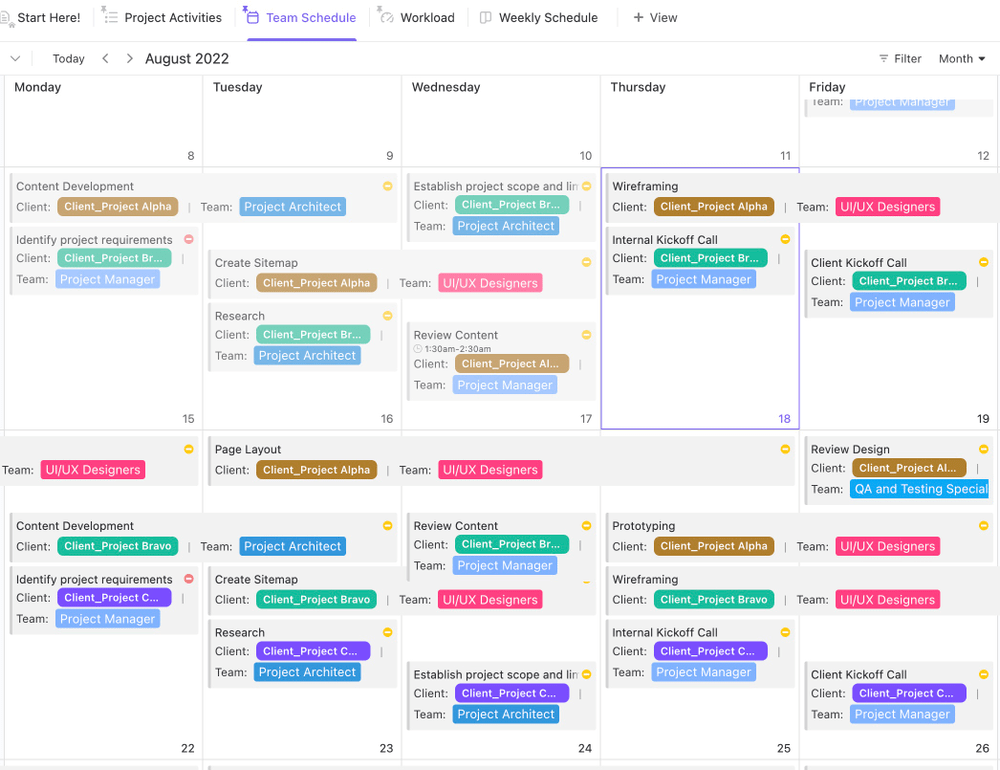
تم تصميم قالب جدول فريق ClickUp لمساعدتك على البقاء منظمًا وعلى رأس جدول فريقك.
2. القدرة على التكيف في حالات الأزمات
تتمثل وظيفة المدير في تتبع ما يجب القيام به ومتى. لذا، هناك مهارة أخرى مهمة يقومون بتطويرها وهي إجراء تعديلات سريعة لاستيعاب التغييرات في الموارد وحالات الأزمات.
يمكن تلخيص جوهر القدرة على التكيف في الدور الإداري في المساءلة. يجب على المدير أن يحمّل نفسه المسؤولية لضمان تحقيق الأهداف النهائية - مثل تسليم المشروع أو الحدث المخطط له - على الرغم من التحديات.
وعادةً ما ينمي المديرون القدرة على التكيف من خلال فهم أساليب عمل الفرق ولوجستيات العمليات، والتنبؤ بالمخاطر، والحفاظ على قنوات اتصال صحية ثنائية الاتجاه تساعد الموظفين على أن يكونوا أكثر تقبلاً للتغيير.
3. مراقبة الأداء ومشاركة الموظفين
تتطلب معظم الأدوار الإدارية هيكلاً تنظيميًا قويًا يتيح التطوير المهني وسهولة الاحتفاظ بالموظفين.
فالمدير الجيد لا يقتصر دوره على إسناد المهام إلى فريقه والانطلاق حتى اكتمال المشروع - فهو يراقب الأداء باستمرار ويحلل مؤشرات الأداء الرئيسية لتحديد الاختناقات المحتملة في الجودة، وتقديم الملاحظات، واتخاذ التدابير التصحيحية لتعزيز فريقهم.
4. عملية صنع القرار الفعالة
المدير العظيم هو المدير الحاسم. إذا كان فريقك عالقًا في مشكلة ما، فلا يمكنك التراجع بعذر ضعيف مثل: لا أعرف، اكتشف ذلك. 🤷
لنفترض أن عليك الإسراع في إطلاق منتج ما. مهمتك هنا هي اتخاذ قرارات لتقليل الاحتكاك التشغيلي. والآن، يمكنك أن تطلب من فريقك تقديم مدخلات. ومع ذلك، في نهاية المطاف، أنت من يجب أن تتحقق من الموارد المتاحة وأعباء العمل الحالية، وتحدد أولويات المهام، وربما حتى تسحب أشخاصًا من مشاريع أخرى لتجعل الجميع على استعداد للالتزام بالموعد النهائي الأكثر صرامة.
بالإضافة إلى ذلك، يجب على المديرين توصيل القرارات في الوقت المناسب، وإفساح المجال للاقتراحات، وتقديم الأسباب المنطقية لتعزيز الشفافية داخل الفرق.
نصيحة: ليس لدى كل مدير الوقت الكافي لتخصيصه لعمليات اتخاذ القرارات المفصلة. لحسن الحظ، يمكنك استخدام قالب شجرة القرار ClickUp لتصور المخاطر والفرص المرتبطة بالحلول المختلفة والتوصل إلى القرارات بشكل أسرع
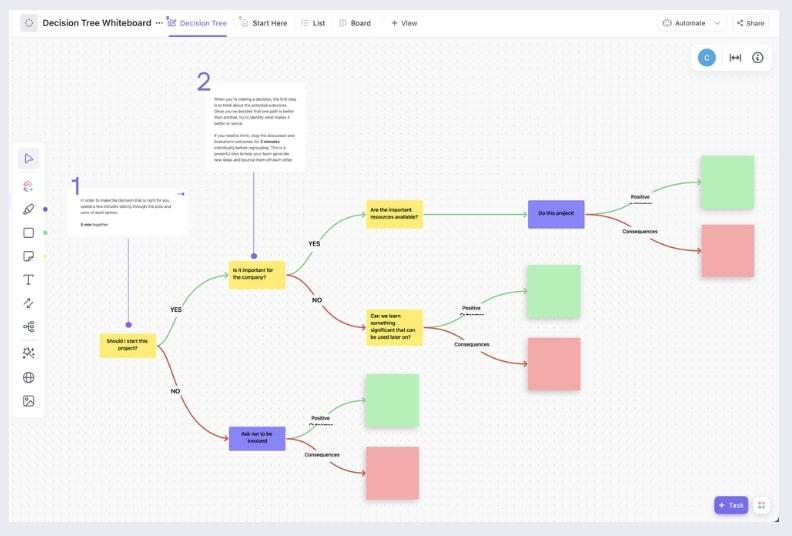
استخدم هذا القالب لتحليل الحلول والخيارات المتاحة، بما في ذلك المخاطر والمكافآت، وتمتع بوضوح أفضل أثناء اتخاذ القرار
مثال على الإدارة الناجحة
مثال تنويري للإدارة الناجحة التي تطورت إلى قيادة رائعة هو حالة أندرو شيرنغ مؤسس سلسلة مطاعم باندا إكسبريس.
افتتح شيرنغ أول مطعم في عام 1973 ومنذ ذلك الحين وسّع إمبراطوريته إلى أكثر من 2400 مطعم في جميع أنحاء الولايات المتحدة! يمكن أن يُعزى نجاحه إلى أنه يضع الناس أولاً أسلوبه في الإدارة والشغف بالتعلم والتحسين المستمر.
كما يستثمر شيرنغ بنشاط في موظفيه ويدفع المديرين الجدد في السلسلة لتقديم أفضل خدمة استنادًا إلى ثلاثة مبادئ:
- كن استباقيًا
- إعطاء الأولوية لتنفيذ المهام بجودة عالية
- كن محترمًا في العمل
القيادة مقابل الإدارة: الاختلافات الرئيسية
القيادة والإدارة في مجال الأعمال مثل الكمان والفيولا في الأوركسترا السيمفونية - فهما متشابهان نوعًا ما ولكن لهما سمات مميزة تسمح لهما بلعب أدوار فريدة من نوعها. 🎻
دعنا نتعمق في بعض الاختلافات الهامة بين الإدارة والقيادة:
الرؤية مقابل التنفيذ
إن أفضل القادة هم أصحاب رؤية - فهم دائمًا ما يكونون متقدمين بخطوة إلى الأمام، ويفكرون في المكان الذي يريدون أن يكونوا فيه في المستقبل ويضعون خطة للوصول إلى هناك.
ومع ذلك، فإن القادة العظماء ليسوا غير واقعيين في رؤيتهم. فهم يدركون قيود العملية ويلهمون الناس على الأداء على الرغم من أوجه القصور هذه. فهم يركزون على الأهداف المستقبلية مع توصيل الجانب لماذا من رؤيتهم لكل عضو من أعضاء الفريق.
من ناحية أخرى، يهتم المديرون بالتنفيذ - فهم يركزون على الحاضر ويمارسون السلطة لإنجاز المهام. في المواقف الضيقة، يتقبل المدير الأمور كما هي ويحاول الاستفادة القصوى من الموارد الموجودة.
يمكنك القول بأن المدراء يحولون أفكار القيادة إلى واقع ملموس.
نصيحة: يستثمر المدراء والقادة الكثير من وقتهم في التخطيط لجدوى الرؤية من حيث العمليات ولكن لا يزال الأمر ينتهي بهم إلى التعارض. والسيناريو الأفضل هنا هو العصف الذهني للأهداف واسعة النطاق وجوانب العمليات ذات الصلة جنبًا إلى جنب مع مراعاة أي عوائق محتملة بشكل استباقي.
إذا كنت بحاجة إلى لوحة مشتركة للعصف الذهني المشترك، فانتقل إلى قالب تدفق عملية ClickUp لتخطيط سير العمل المرئي الغني.
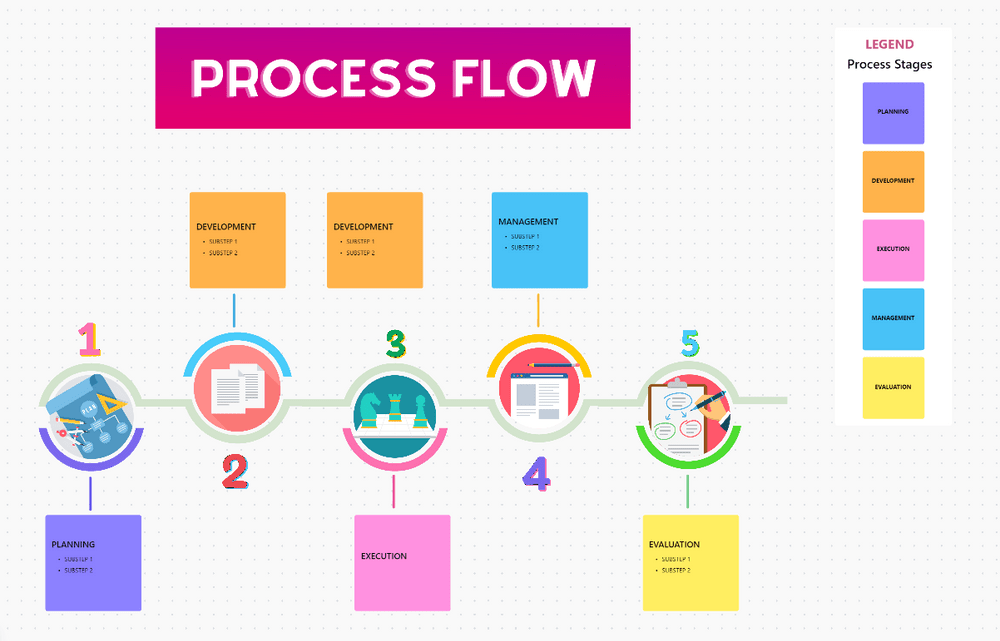
تبسيط تصور المشروع من خلال نظرة عامة واضحة وموجزة لسير العمل من البداية إلى النهاية
الإلهام مقابل التحكم
القادة يلهمون الآخرين ويحفزونهم على تحقيق أهداف كبيرة ويغرسون الإحساس بالهدف في فرق العمل. تظهر الأبحاث.) أن القيادة الفعالة والتحفيز الناتج عنها يعززان الرضا الوظيفي والإنتاجية.
لكن القادة لا يهتمون بـ السيطرة على العمليات اليومية، بل المديرون هم المعنيون بذلك. فهم ينفذون العمليات ويتحققون مما إذا كانت جميع المهام تسير على المسار الصحيح لتحقيق الأهداف التنظيمية. يمكنك القول أن اهتمام المدير ينصب على المستوى الجزئي للأشياء التي تساعد في النهاية على تحقيق مهمة الشركة التي حددها القادة.
الابتكار مقابل التنظيم
كما قال الباحث وارن بنيس المدير يدير، والقائد يبتكر. تلخص هذه العبارة فرقًا مهمًا بين الدورين - فالقادة يفكرون دائمًا في التحسين. فهم يسعون باستمرار إلى الابتكارات والتغييرات المؤثرة التي يمكن أن تساعدهم على حل المشاكل والتغلب على التحديات. إن الوضع الراهن هو أكبر مخاوفهم، ومهمتهم هي الهروب منه ومواصلة الصعود على السلم. 🪜
المديرون الناجحون يديرون العمليات الحالية دون اعتبار يذكر للوضع الراهن. فهم يهتمون بالحفاظ على سير الآلة بسلاسة.
لذلك، يعمل المديرون على تحقيق أهداف محددة مسبقًا باستخدام الأدوات المتاحة بالفعل في صندوق أدواتهم. فهم لا يبحثون عن أدوات أفضل - فهذه مهمة القادة.
المكافأة: قالب إدارة أفكار الابتكار في ClickUp هو نموذج لا بد من تجربته لكل من القادة والمديرين لأنه لا يساعد فقط في إدارة الأفكار الجديدة بل يدعم أيضًا عمليات التنفيذ.
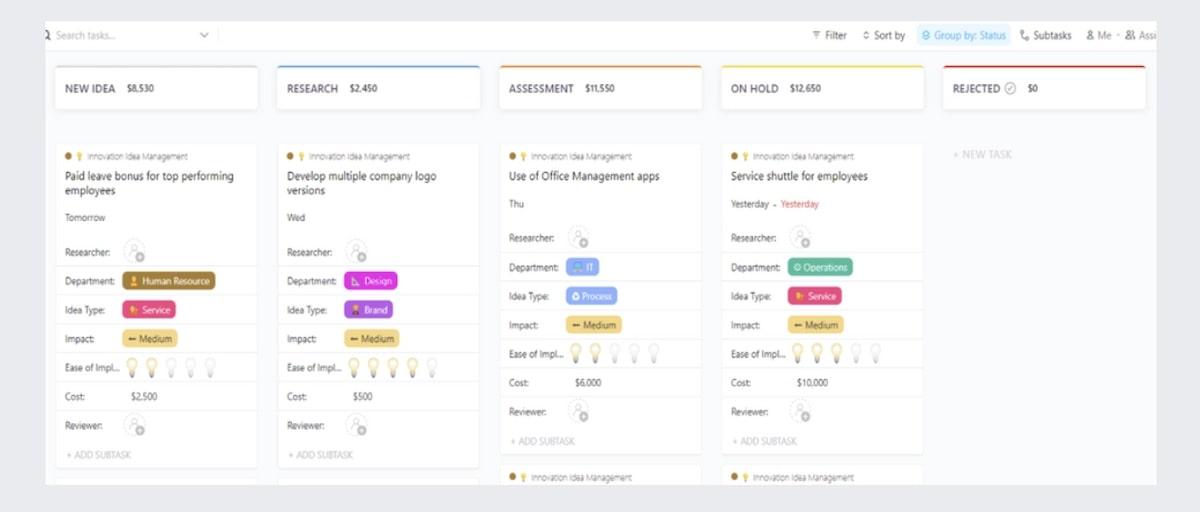
يمكن للمديرين والقادة استخدام قالب إدارة أفكار الابتكار ClickUp لإدارة أفكار الابتكار لالتقاط الفرص الحساسة للوقت وتتبعها وتحديد أولوياتها معًا
أين تتقاطع القيادة والإدارة؟
ليس من قبيل المصادفة أنه غالبًا ما يتم الخلط بين القيادة والإدارة واستخدامهما بالتبادل. يتقاطع نطاق هذين المفهومين في عدة جوانب أهمها
- وضع الاستراتيجيات: يضع القادة استراتيجيات طويلة الأجل لتحقيق مهمتهم. بينما يهتم المديرون بالاستراتيجيات قصيرة الأجل التي تمكنهم من إنجاز المهام في المواعيد النهائية
- مهارات اتخاذ القرار: يجب أن يكون كل من القادة والمدراء قادرين على جمع البيانات وتحليلها وتقدير المخاطر واختيار أفضل مسار للمضي قدمًا. فهم مسؤولون عن أعمالهم ولا يمكنهم إلقاء اللوم على الآخرين عن الإخفاقات الناجمة عن القرارات السيئة
- التركيز على فرق العمل: من أوجه التشابه المهمة الأخرى دور القادة والمديرين في تعزيز ثقافة الشركة الصحية ورضا الموظفين. ففي ظل القيادة والإدارة الجيدة، يزدهر أعضاء الفريق ويشعرون بالمشاركة والتقدير، ومن غير المرجح أن يستقيلوا. على العكس من ذلك، فإن القادة والمديرين الضعفاء يثقلون كاهل فرقهم بتوقعات غير واقعية تؤثر سلبًا على مكان العمل
- الاتساق: وأخيرًا، يجب أن يحافظ كل من القادة والمديرين على الاتساق بين أقوالهم وأفعالهم ليظهروا كشخصيات موثوقة 🫡
3 من أفضل الممارسات والنصائح لكي تصبح قائدًا ومديرًا جيدًا
يعد كل من القادة والمديرين شخصيات تواجه الموظفين، وإن كان ذلك بصفات مختلفة. فيما يلي ثلاث أفضل الممارسات المشتركة لأداء أي من الدورين بنجاح:
1. كن قدوة يحتذى بها
إذا كنت تريد أن يحترمك الناس ويثقوا بك، يجب أن تكون قدوة وأن تمارس ما تعظ به. ففريقك يراقب طريقة عملك - إذا كنت تتكلم بالكلام ولا تسير على خطاك، فلن يميلوا إلى اتباع خطاك أو رؤيتك كشخصية موثوقة.
إليك بعض الصفات التي يجب أن تتحلى بها لتكون المدير والقائد العظيم الذي يوفر الاستقرار لفريقه:
- التركيز على حل المشاكل لفريقك
- الحفاظ على التواضع والشفافية في التعامل مع الموظفين
- تقديم إرشادات وأمثلة واضحة عند الحاجة
- إجراء حوار مفتوح مع فرق العمل ودعوة الآراء
- كن موجهاً نحو تحقيق النتائج ولكن داعماً في نفس الوقت
- تفويض اتخاذ القرارات ذات المخاطر المنخفضة لإظهار ثقتك بفريقك
2. استمع إلى فريقك
يساعدك التحقق من نبض فريقك بين الحين والآخر على تكوين فكرة عن مستويات رضاهم ومشاركتهم، مما يساعدك على تحسين قيادتك ومهاراتك الإدارية.
مارس الاستماع النشط عند النظر في وجهات نظر فريقك ومواقفهم تجاه العمل أو قرار معين. انتبه إلى آرائهم حول أوجه القصور في العمليات ومشكلات الجدولة والعوائق التشغيلية، واطرح المزيد من الأسئلة، وطرح المزيد من الأسئلة، ووضع حلول أفضل لتحقيق الأهداف وتحسين ديناميكيات الفريق .
3. استخدم الأدوات المناسبة للتعاون ونجاح الأعمال
على مدى العقود الماضية، أثرت أدوات برمجيات الأعمال والتواصل بشكل كبير على كيفية عمل القادة والمديرين. لم يعد عليك الاعتماد على الأعمال التي تستغرق وقتًا طويلاً مثل التحقق من حالات المشاريع يدويًا أو تنظيم اجتماعات طويلة لمشاركة تفاصيل المهام. كل ما تحتاجه هو إدارة العمل بشكل جيد حل ل:
- التواصل والتعاون مع فرق العمل
- وضع أهداف واضحة وتخطيط الجداول الزمنية
- إنشاء قاعدة معرفية لدعم الموظفين
توصيتنا هي انقر فوق مهمة الكل في واحد و حل إدارة المشاريع مع ميزات لتركيز العمل وتبسيط العمليات والتعاون مع الفرق على أي نطاق. لا تدعم المنصة عملية اتخاذ القرارات المدعومة بالبيانات فحسب، بل تتيح لك أيضاً مزيداً من الوقت للتركيز على وضع الاستراتيجيات وحل المشكلات.
لنرى كيف تساعدك منصة ClickUp في الأدوار القيادية والإدارية. 🌺
استخدم مجموعة ClickUp لإدارة المشاريع كمركز قيادة لك
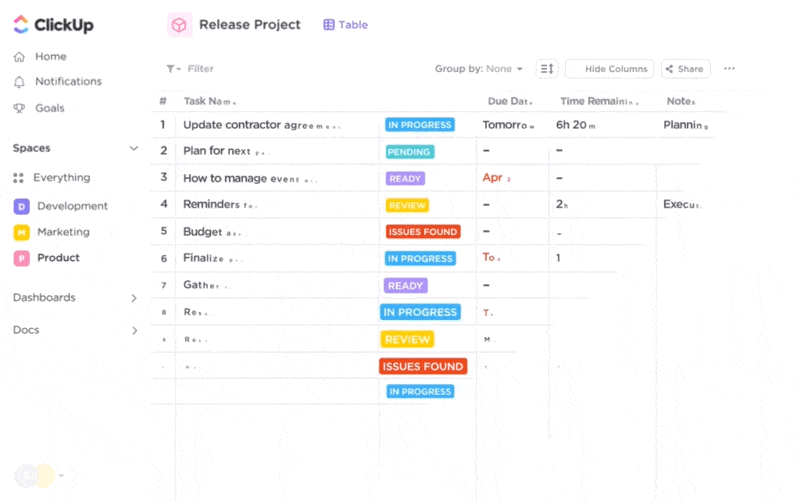
ركز على ما هو أكثر أهمية مع ClickUp Project Management
الـ ClickUp إدارة المشاريع مجموعة ميزات قوية تتيح لك إنشاء المهام وتنظيمها ومراقبتها، وتبديل وجهات النظر، وتحديد الأولويات، والتواصل - كل ما يحتاجه القائد أو المدير الجيد. 😎
بالنسبة للمبتدئين، يمكنك تمكين الفرق من خلال إنشاء قاعدة معرفية مركزية في مستندات ClickUp . فبدلاً من مشاركة الاستراتيجيات والرؤى وخطط المهام من خلال اجتماعات مفصّلة، يمكنك تجميع كل أصولك المعرفية في مجلدات منظمة، مما يتيح لموظفيك الدعم السلس أثناء تنفيذ مهامهم.
يساعد ClickUp أيضًا في الجدولة المرنة للمشاريع. استخدم مهام ClickUp , التقويم و مخططات جانت لإنشاء العمل وتعيينه وتصنيفه وتتبعه ببضع نقرات.
تغيير وجهات النظر مع أكثر من 15 طرق عرض ClickUp -من الأساسي قائمة و مشاهدات المجلس إلى خيارات متقدمة لـ تصور أعباء العمل أو الجداول الزمنية للمشروع . قم بتبديل طرق العرض لتحديد أوجه القصور والعقبات في وقت مبكر و تحسين الموارد أثناء التنقل
ستقدر ميزات التواصل التعاوني مثل ClickUp Chat و تعيين التعليقات . استخدمها لتبادل الرسائل مع الفرق متعددة الوظائف في الوقت الفعلي دون مغادرة المنصة. استفد من ميزة الإشارات للصراخ السريع لزملائك في الفريق.
تكمن الفكرة من وراء هذه الميزات في مساعدة القادة والمديرين على البقاء على اتصال مع القوى العاملة لديهم دون عناء، مما يعزز ثقافة الشركة الصحية واتخاذ قرارات أكثر سلاسة.

اجمع اتصالات الفريق معًا في مساحة واحدة مع ClickUp Chat وشارك التحديثات واربط الموارد وتعاون دون عناء
يمكنك أيضًا استخدام ClickUp Whiteboards لتبادل الأفكار مع فريقك. إنها لوحات رقمية مثالية لوضع الاستراتيجيات وحل المشكلات. استخدمها لوضع خطط قصيرة وطويلة الأجل والانتقال من الأفكار إلى الواقع. 🧠
استفد من أهداف ClickUp Goals لتتبع الأهداف المحسنة
سواء كنت قائدًا أو مديرًا (أو كليهما)، فأنت دائمًا تعمل على تحقيق هدف ما. ومع ذلك، لن يتبعك الآخرون أو يثقون بك إذا كنت أهدافك قصيرة أو طويلة المدى غير واضحة أو غير واقعية. مع أهداف النقر يمكنك تحديد أهدافك وإدارتها وتعديلها وتتبع نسب الإنجاز ومراقبة أهداف التسليم.
اختر نوع الهدف (رقم أو صواب/خطأ أو عملة أو مهام) واسمح لـ ClickUp بـ تتبع الأهداف لك! نظّم الأهداف في مجلدات لتسهيل التنقل والتحكم.
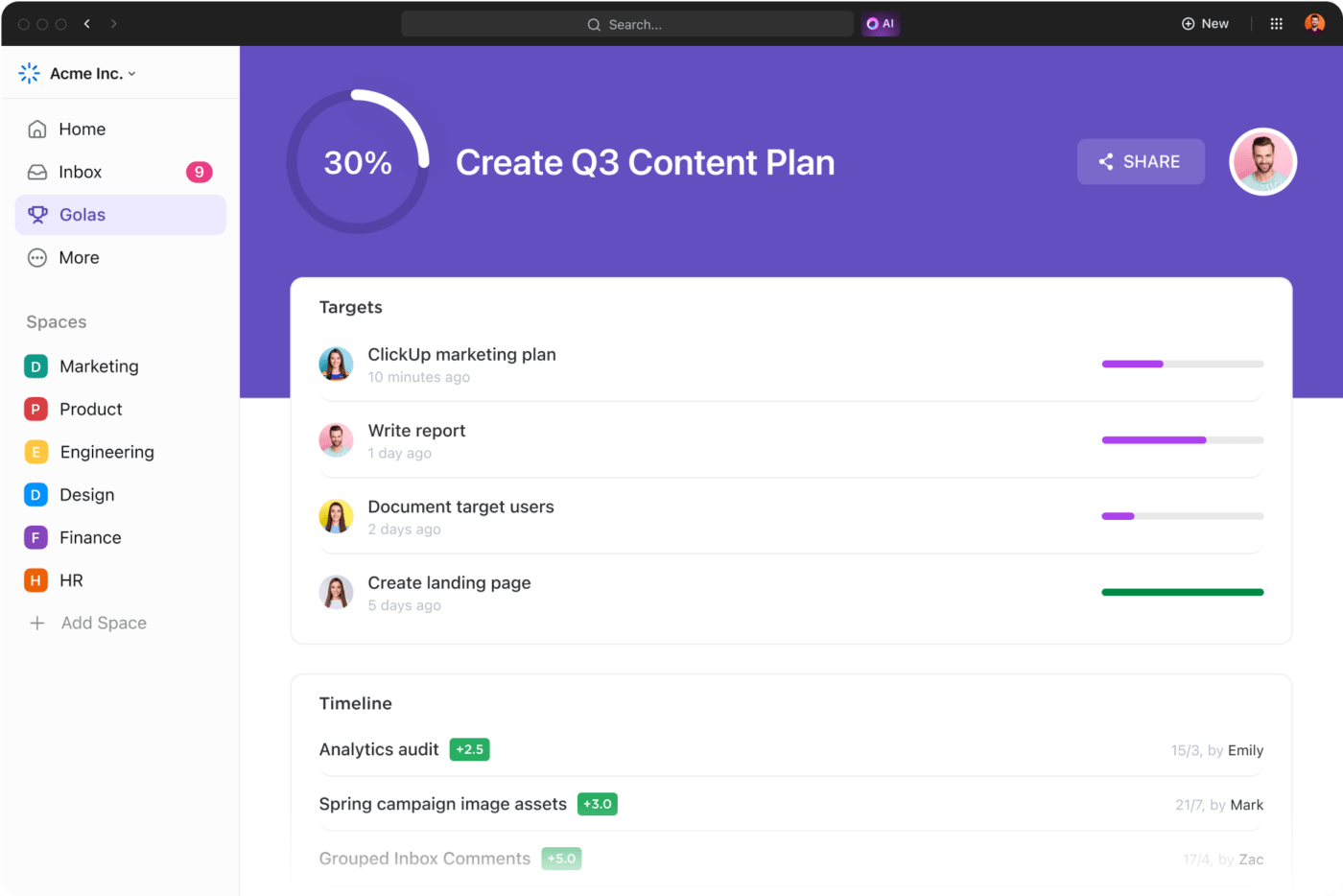
إنشاء أهداف قابلة للقياس للمهام والمشروعات مع التقدم التلقائي لتحقيق الأهداف بفعالية أكبر مع جداول زمنية محددة وأهداف قابلة للقياس الكمي
يجب على القادة والمديرين أيضًا تعيين المعالم الرئيسية لتحديد نقاط التقدم الرئيسية في المشاريع. وهذا يساعدهم على مراقبة الأهداف واسعة النطاق دون إدارة موظفيهم بشكل دقيق.
إعداد مخصص لوحات معلومات ClickUp هي طريقة أخرى لمراقبة الأهداف ومقاييس الأداء من بعيد. يمكنك تنظيم لوحة التحكم الخاصة بك لعرض البيانات في الوقت الفعلي، مثل الوقت الذي تم تتبعه أو المبيعات التي تم تحقيقها، والاستمتاع برؤى قابلة للتنفيذ على مدار اليوم. 😏
احتضان اتساق التواصل مع قوالب ClickUp
الريادة و إدارة الفرق أسهل باستخدام قوالب ClickUp - فهي تحتوي على أقسام معدة مسبقًا لمساعدتك على التواصل بشكل متسق عبر حالات الاستخدام المختلفة وبأقل قدر من الأخطاء!
إذا كنت ترغب في تحديد أهداف واضحة ووضع خطة عمل مثمرة لبدء نجاح مؤسستك، جرّب ClickUp قوالب خطة التطوير . يمكن أن تساعدك على تنظيم الأفكار بشكل أكثر احترافية وحتى استكشاف نطاق نمو الموظفين.
إذا كنت تقوم بتوسيع فرق القيادة أو الإدارة لديك، فقم بالتخطيط لعمليات الانتقال المقترحة مع نماذج تخطيط التعاقب الوظيفي . ستساعدك هذه النماذج على تحديد الأدوار والمناصب، وتسليط الضوء على المسؤوليات المتوقعة، وتصميم خطة عمل شفافة للمستقبل. يمكنك استكشاف مكتبة ClickUp التي تحتوي على أكثر من 1,000 خيار قالب للقيادة والإدارة. 💗
القيادة مقابل الإدارة: تنفيذ رؤيتك مع ClickUp
قد تختلف القيادة والإدارة في العديد من الجوانب، لكن كلتا الوظيفتين تساهمان بنفس القدر في نجاح المؤسسة. ولحسن الحظ، يمكنك الاستفادة من أدوات مثل ClickUp لتنفيذ جميع أنواع المهام كقائد ومدير.
مع ميزات لـ تحديد الهدف والتواصل، والتعاون، ومراقبة التقدم المحرز، فإن ClickUpp مركزية الجوانب المتنوعة لكلا الدورين وتمنحك التحكم الكامل في عملك. اشترك اليوم وانطلق بشركتك نحو النجاح! ✨
![القيادة مقابل الإدارة: ما الفرق بينهما؟ [مع أفضل الممارسات لإشراك الموظفين]](https://clickup.com/blog/wp-content/uploads/2024/03/Leadership-vs-Management-Blog-Feature.png)

